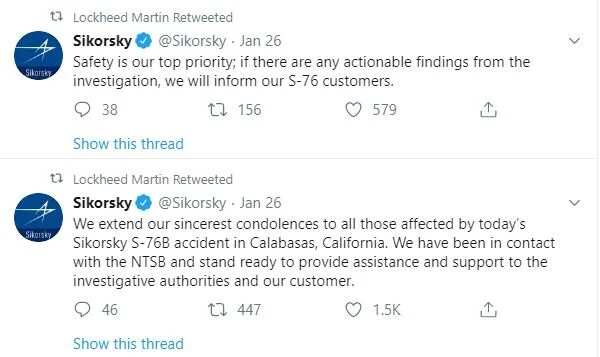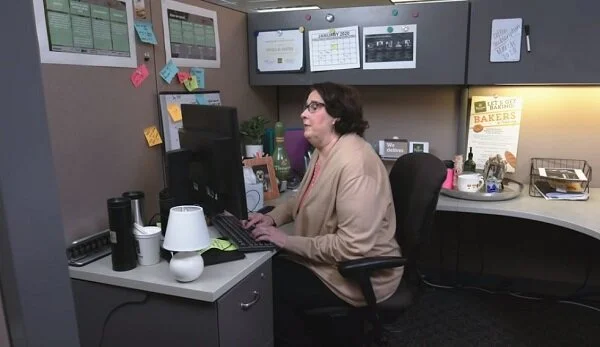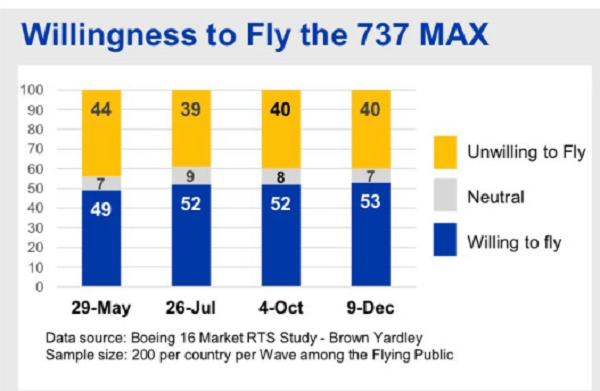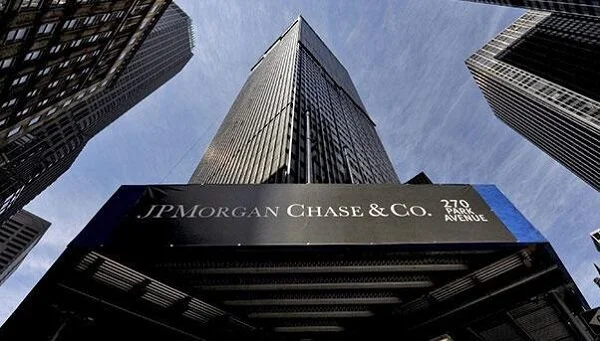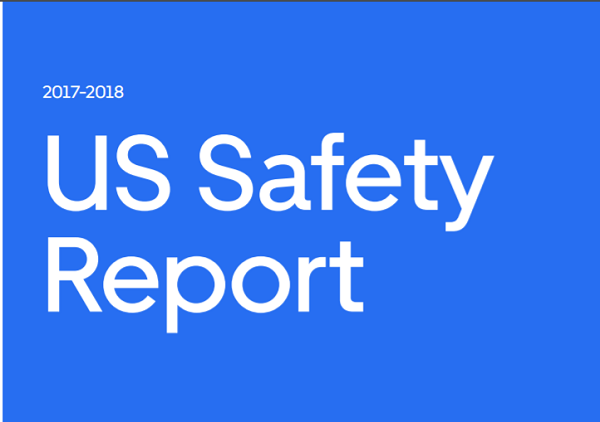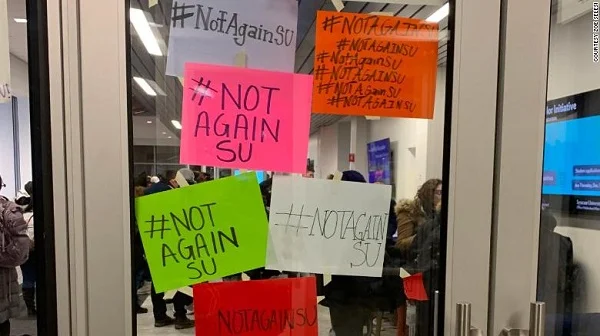Communications About Kobe Bryant
NBA superstar Kobe Bryant, his daughter, and seven others died in a helicopter crash, and many are mourning the loss. At the Emmy’s, celebrities paid tribute to his life, and the NBA postponed a Lakers—Clippers game.
The helicopter company, Sikorsky, owned by Lockheed Martin, posted two tweets and a short statement on its website:
We extend our sincerest condolences to all those affected by the January 26th Sikorsky S-76B accident in Calabasas, California. We have been in contact with the NTSB and stand ready to provide assistance and support to the investigative authorities and our customer. Safety is our top priority; if there are any actionable findings from the investigation, we will inform our S-76 customers.
Discussion:
Analyze the Sikorsky messages. Who are their primary and secondary audiences? What are the communication objectives, and how well did the company achieve them?
Have you seen other communications from Sikorsky? Should the company do or say more? If so, what?
Starbucks' Sustainability Commitment
Starbucks CEO Kevin Johnson published a statement of the company’s commitment to sustainability, outlining several new initiatives. Johnson explains the rationale for the commitment, what the company has already done, and what plans are in place for the future.
The message lists three “preliminary targets” for 2030:
A 50% reduction in carbon emissions in our direct operations and supply chain.
50% of our water withdrawal for direct operations and coffee production will be conserved or replenished with a focus on communities and basins with high water risk.
A 50% reduction in waste sent to landfill from stores and manufacturing, driven by a broader shift toward a circular economy. To underscore this commitment, we are pleased to join Ellen MacArthur Foundation’s New Plastics Economy Global Commitment, setting ambitious circular targets for our packaging.
Discussion:
Analyze the statement: the audience, communication objectives, organization, writing style, etc. What works well, and what could be improved? Why is “preliminary targets” italicized?
How well does the company meet its communication objectives with this message?
How, if at all, does this message change your perception of Starbucks?
Panera Extends Social Media Listening
Panera responded to complaints about its Bistro French Onion soup with a clever approach: hiring the character Phyllis from “The Office” TV show.
The restaurant chain had promised that the soup would return, but it didn’t, and fans protested on social media. In addition to actively responding to customer complaints on social sites, Panera created a video showing a fake social media manager and Phyllis, as a social media coordinator.
The approach shows that Panera is listening and responding to customers, and it helps customers see the company’s point of view.
Discussion:
What’s your view of the video? How would you describe the potential impact in a few words?
More specifically, what are the communication objectives for this video message? Consider the audience and what the company hopes customers will do, think, and feel differently after watching the video.
Emails Show USC's Potential Role in the Admissions Scandal
Actress Lori Loughlin and her fashion-designer husband Mossimo Giannulli have been charged with bribing University of Southern California athletic officials to get their daughter admitted. Now emails from USC show that the school was courting them by asking for donations and arranging for personalized campus tours. In one email, a university official wrote, “I’d also be happy to flag her application.”
A New York Times article summarizes how accused parents plan to defend themselves against charges:
Motions by several of the defendants suggest they will argue, essentially, that they could not have defrauded the university, as prosecutors say, because the university was actively seeking such donations and offering a leg-up in admissions in return.
In a statement, USC downplayed the special treatment:
“What was being offered to the Giannullis was neither special nor unique. Tours, classroom visits and meetings are routinely offered. The primary purpose of a flag is to be able to track the outcome of the admission review process. It is not a substitute for otherwise being qualified for admission to USC.”
Parents are expected to say that their donations were legitimate, but USC is expected to say that the bribery was specific to the crew team official, who “agreed to pass the couple’s two daughters off as coxswains.”
Discussion:
What’s your view of this situation? Do you agree more with the parents’ or with the school’s perspective?
What, if anything, do the school’s emails reveal? Consider this message to the parents: “Please let me know if I can be at all helpful in setting up a 1:1 opportunity for her, customized tour of campus for the family, and/or classroom visit?”
Carlos Ghosn's News Conference
Former head of Nissan Motor Co. and Renault SA Carlos Ghosn delivered a news conference from Lebanon after his escape from Japan. Ghosn was arrested in Tokyo in 2018 for misreporting income and misusing company funds. He left through a well-orchestrated exit in a box by private plane to his home country.
In what the Guardian calls “a lengthy and often rambling press conference in Beirut,” Ghosn spoke in four languages to defend himself. He criticized the Japanese criminal justice system and accused the Japanese government of working with Nissan executives to conspire against him.
Ghosn was adamant about his innocence:
“I don’t consider myself as a prisoner in Lebanon. I prefer this prison to the one before. I am ready to stay a long time in Lebanon, but I am going to fight because I have to clear my name.”
The Japan Times reports that the new conference “will have done little to turn the tide of public opinion in Japan and restore his reputation, which has been tainted by his alleged financial wrongdoing.” A former prosecutor in Japan said, “Ghosn didn’t have anything substantive to say. If he wants to restore trust, he shouldn’t do a self-absorbed speech like he did, but he should calmly make specific explanations and present evidence supporting those explanations.”
Discussion:
Watch parts of the news conference. How well does Ghosn restore his image and prove his innocence?
How should Ghosn communicate differently if he wants better outcomes?
Wells Fargo Earnings Call
The Wells Fargo scandal of creating fake accounts became public in 2016, and the company is still suffering the repercussions. Profit is down 53%, and stock performance is lagging.
On an earnings call, Charles Scharf, who has been the CEO since October 2019, explained the bank’s current position:
I was honored to be chosen to lead Wells Fargo because I believe this is an extraordinary company that plays an important role in this country. We came out of the financial crisis as the most valuable and most respected bank in the US, but as you know, we made some terrible mistakes and have not effectively addressed our shortcomings. These circumstances have led to financial underperformance, but we have one of the most enviable financial services franchises in the world and employees that want to do what's necessary to again be one of the most respected and successful banks in the US.
Discussion:
Read the earnings call transcript. What’s your view of how Scharf and John R. Shrewsberry, EVP and CFO, addressed concerns?
How well has the bank recovered its image since 2016? What examples of their communications can you cite?
What could bank executives have done differently in the past four years?
How well does the line chart work to compare Wells to other leading banks? What could be improved?
WSJ Opinion About Boeing Emails
A Wall Street Journal writer argues that Boeing employee emails “explain nothing.” A previous WSJ article concluded that emails demonstrated a “cavalier attitude towards safety,” and a Reuters article concluded that employees “distrust the 737 MAX” and “mock regulators.”
The opinion writer, Holman Jenkins Jr., argues, “all of corporate America, not just Boeing, lives these days by employing creative, freethinking people who spout off acerbically, critically and colorfully in electronic messages.” Jenkins questions the reporting of these emails and what is omitted.
Jenkins also asks why these employees didn’t write about MCAS design flaws: “If the hypercritical people seen in these messages had known about MCAS’s design flaws, it never would have gotten through.” He also notes that the only emails referring to MCAS were from 2013, although system changes were made in 2016.
Discussion:
Read Jenkins’ article. What do you consider to be his strongest and weakest arguments?
Based on his argument and your own reading of media reports, what’s your opinion about the significance of the emails?
What issues of integrity does this situation raise?
Boeing Internal Documents Don't Reflect Well on Safety
The lead article in today’s The Wall Street Journal is titled, “Internal Boeing Documents Show Cavalier Attitude to Safety.” In 150 pages of emails and other documentation, employees worry that they don’t have enough time to correct safety issues and refer to regulators as “morons” and “stupider.”
In February 2018, one employee wrote, “Would you put your family on a MAX simulator trained aircraft? I wouldn’t.” A pilot wrote, “I still haven’t been forgiven by god for the covering up I did last year. Can’t do it one more time. Pearly gates will be closed.” Still another employee wrote, “This airplane is designed by clowns, who in turn are supervised by monkeys.”
A defense attorney argues that employees were just “blowing off steam” in their emails.
In the past few months, Boeing’s culture has come to light—once lauded as a place where people felt proud to work but now a place where people feel stressed and remorseful. CEO Doug Muilenberg has since been terminated and replaced temporarily by CFO Doug Smith.
Discussion:
Read more about the internal communications. What lessons can employees and their managers take away from this story?
What’s your view of the emails? Do they indicate big problems at the company, or is the attorney right that employees are just venting to each other? How does the concept of “cherry picking” come into play?
What should Boeing do to manage this situation? Consider this news in light of the company’s crisis communication planning you read about in another post.
Facebook Memo Goes Public
Facebook executive Andrew Bosworth wrote a 2,551-word memo about the company’s role in the upcoming election and more. Bosworth compliments President Trump’s use of Facebook ads and admits that the site impacted the 2016 U.S. election. A Vox article describes Boswell’s logic:
Bosworth’s memo has much more in there, which is getting plenty of deserved attention, including the assertion that Facebook did indeed help Donald Trump win the 2016 election — by giving him the tools to run “the single best digital ad campaign I’ve ever seen from any advertiser. Period.” And the memo also reveals that Bosworth, a self-described “committed liberal,” fantasizes about using Facebook to prevent Trump from winning in 2020, but won’t.
The memo is also attracting attention because Bosworth compares Facebook to sugar and places responsibility on the user: “At the end of the day we are forced to ask what responsibility individuals have for themselves."
Bosworth ends the memo with a question:
To bring this uncharacteristically long and winding essay full circle, I wanted to start a discussion about what lessons people are taking away from the press coverage. My takeaway is that we were late on data security, misinformation, and foreign interference. We need to get ahead of polarization and algorithmic transparency. What are the other big topics people are seeing and where are we on those?
Discussion:
Read the entire memo . What surprises you most?
How damaging is the memo to Facebook’s image, particularly with another election coming up? How does a memo like this—posted on an internal site—become public?
What business writing principles does Bosworth follow, and how could he improve the memo?
Boeing's Crisis Communication Plan
During the holiday break, several news items about Boeing were relevant to business communication and character. In one article, the New York Times revealed internal Boeing documents showing a company trying to rebuild its image after two MAX crashes within a year..
The documents give us an inside view of how the company plans to use persuasive strategies to win back customers. In one graphic, we see customers’ willingness to fly. In another, we see customer concerns and ways Boeing can address them, for example, with FAQ cards, “pilot confidence videos,” or personal connections (for example, “Flight attendant offers comfort and information on the safety of the MAX”).
Discussion:
What persuasive strategies does the company plan? Try to find examples of logical argument, emotional appeal, and credibility.
What are the consequences of this information becoming public? Does it likely endear the public to the company’s concerns, embarrass the company, or something else?
Accountability in the News
Two situations this week remind us that CEOs should take accountability for mistakes in their companies.
On an investor call, Home Depot CEO Craig Menear said retail theft is on the rise:
“This is happening everywhere in retail. We think this ties to the opioid crisis, but we’re not positive about that.”
Menear faced criticism on Twitter for blaming the opioid crisis rather than taking responsibility for product loss at a warehouse.
On another call, Costco CFO Richard Galanti talked about losses because of a website crash:
"It was unfortunate. Despite all the efforts to have plenty of processing capacity, if you will, there was something that occurred." He also acknowledged, “[W]e did leave something on the table.”
In both situations, the executives could be more direct.
Discussion:
Do you agree with my assessment? Why or why not?
What evidence should Costco provide to back up its claim?
What else could the executives have said differently? (Hint: Note Galanti’s use of passive voice.)
In addition to accountability, what leadership character dimensions are illustrated by these examples?
Best Places to Work: Facebook and Google Slip
Glassdoor published its annual list of the Best Places to Work, and HubSpot is the winner. Glassdoor uses the following criteria for their ranking:
A mission to believe in
A strong culture
People focused
Transparency
Facebook fell to 23 after placing first in three of the past 20 years. Google feel below the Top 10 for the first time in eight years.
Here’s the 2020 list:
HubSpot
Bain & Co.
DocuSign
In-N-Out Burger
Sammons Financial Group
Lawrence Livermore National Laboratory
Intuitive Surgical
Ultimate Software
VIPKid
Southwest Airlines
Discussion:
Why do you think Facebook and Google have slipped in the Glassdoor rankings?
What surprises you about the Top Ten? What doesn’t surprise you?
Is your favorite company on the full list? How does the ranking affect your view of the company?
JPMorgan Recorded Phone Conversation
Jimmy Kennedy, an African-American former National Football League player, tried to open a private wealth account at JPMorgan but had trouble getting attention. He recorded a conversation with an African-American employee, Richardo Peters, who said, “You’re bigger than the average person, period. And you’re also an African-American. We’re in Arizona. I don’t have to tell you about what the demographics are in Arizona. They don’t see people like you a lot.”
In a New York Times article that published the recording, Peters recounted a specific example of discrimination against a Black customer. When he was trying to bring on another new client, who had received a large settlement, his manager said, “You’ve got somebody who’s coming from Section 8, never had a nickel to spend, and now she’s got $400,000, What do you think’s going to happen with that money? It’s gone.” His manager’s position was that the customer would not invest money with the bank.
Other incidents at the bank led to Peters’ termination, and he is suing for racial discrimination. JPMorgan also recently settled a class-action lawsuit for $24 million to Black employees who claimed discrimination: according to a New York Times report, “in some cases by isolating them from colleagues and dumping them in poorer branches.”
A few days later, CEO Jamie Dimon addressed the situation in a memo to employees.
Discussion:
How do you assess this situation at JPMorgan? Read more in the NYT article.
A February Essence article describes and praises JPMorgan’s Advancing Black Pathways program to support the Black community. What’s your view of the effort in light of this news?
How do you assess CEO Jamie Dimon’s response in the memo? We don’t see the entire memo, but CNBC posted quotes.
Data in the Uber's Safety Report
Uber published its first safety report, and the company is lauded for its transparency. A Wall Street Journal article leads with the number of sexual assaults reported during the last two years: 5,981. Of course, any number is too many—no one should be assaulted in an Uber or anywhere else. And sexual assaults are notoriously underreported, so we have no idea how many have actually occurred.
At the same time, a skeptic might want to know the total number of rides in order to put the number of reports in context. The report does provide this information (see the report for footnotes):
The report makes additional attempts to put the numbers in context:
All of that work culminates in the Safety Report that we are sharing with you, the public, today. To put US safety challenges in context:
• In 2018, over 36,000 people lost their lives in car crashes in the United States alone (3)
• Approximately 20,000 people were the victims of homicide in 2017(4)
• Nearly 44% of women in the US have been a victim of sexual violence in their lifetime—which means that more than 52 million women live with that experience every day (5)
Every form of transportation is impacted by these issues. For example, the NYPD received 1,125 complaints of sex offenses in the transit system during the same time period covered by this report.(6,7) In the United States alone, more than 45 rides on Uber happen every second. At that scale, we are not immune to society’s most serious safety challenges, including sexual assault. Yet when collecting data for that portion of our report, we found there was no uniform industry standard for counting and categorizing those types of incidents.
The 84-page report is incredibly detailed and includes external reports for credibility and the number of charges for various types of assaults.
Discussion:
Analyze the report: the audience, communication objectives, organization, writing style, format. What works well, and what could be improved?
Does the context in these examples convince you that the numbers aren’t so bad? Why or why not?
Otherwise, how well does Uber address the safety issues? How do you assess the report credibility? What other questions do you have?
Why Entrepreneurs Don't Learn from Their Mistakes
A Wall Street Journal article describes research about failing entrepreneurs. The results are sobering: start-up business owners don’t seem to learn from their mistakes.
Francis Greene, at Edinburgh University Business School, explains several reasons for lack of learning. First, when entrepreneurs start new businesses, they have a different context and different customer, so any lessons learned from previous businesses might not apply. Greene also says that businesses typically “limp along”; during this slow-close process, it’s difficult to identify what the real problems were.
Finally, as you might expect, we have psychological barriers for failing to learn from failure. We tend to simplify reasons and blame external factors.
Greene suggests taking time to explore what happened after a business failed and ensuring that we have the industry expertise to succeed in the next venture.
Discussion:
This reminds me of Amy Edmondson’s HBR article, “Strategies for Learning from Failure.” What similarities and differences do see in their research findings and recommendations?
When have you failed? How did you learn from the experience? Can you identify ways to learn better in the future?
Should We Call Climate Change Something Else?
An AdAge writer wonders whether renaming climate change would change perceptions. Reframing is a common strategy for influencing behaviors, thoughts, and feelings. Already, climate change seems to be the evolution of global warming, a less convincing idea, in part, because sometimes it’s quite cold, as President Trump says.
A brand team pondered the following new names:
Global Meltdown, Global Melting
Climate Collapse, Climate Chaos
Boiling Point, Melting Point
Scorched Earth
Discussion:
The author identifies “parameters and guideposts” for the new name: audience, reach, and message. What is important for each of these categories?
What’s your view of the proposed new names? Which do you like best and least, and why?
Meanings Behind OK, K, and kk
According to a New York Times article, the way to “scare your young co-workers” is to type “O.K.” instead of “kk.” A young worker explains:
To write “O.K.” or “K,” they tell me, is to be passive-aggressive or imply that I would like the recipient to drop dead.”
The article puts this generation gap in perspective:
A parting thought: Sociolinguistic research — which, until recently, tended to treat gender as binary — largely indicates that young women are the drivers of language change. (The authors of a frequently cited 2009 article from the journal “Language” found that men often lag “a full generation behind” — perhaps because they “retreat from or resist a change after it becomes associated with women.”) I don’t know for sure if the co-workers you mention are women but, on the off-chance you work with any, it’s never a bad time to remind yourself that studies (and women) find that women who talk at work are regularly dismissed, interrupted or ignored.
Discussion:
What’s your view of the differences among “Okay,” “O.K.,” “OK,” “K,” and “kk”? Do you see them the way this article describes? What, if any, role does gender play in your interpretation?
The article reminds me of a 2015 study about periods in texts, apparently a signal for something dramatically final instead of how I use them—to end sentences like this one. How has punctuation use in texts changed over time?
Communications Criticized at Syracuse University
A Chronicle of Higher Education article says that communications at Syracuse University “didn’t help” the racial issues. In the past few weeks, videos, slurs, and drawings, such as swastikas, culminated in a rumor that a “white-supremacist manifesto” was sent to students’ phones. The manifesto was said to be a copy of the one associated with the March New Zealand shootings, and Chancellor Kent D. Syverud responded, “It was apparent that this rumor was probably a hoax, but that reality was not communicated clearly and rapidly enough to get ahead of escalating anxiety.”
The response didn’t address student concerns, which have been bubbling for years. Syverud was criticized for his response in 2014 during campus protests about climate. To the recent racist incidents, students are demanding quicker and more direct action. The chancellor’s choice of words is also at issue, as expressed by Mona Lisa Faz, a graduate student of communications:
“Since when did calling someone the n-word or creating a swastika in the snow ever count as bias?” she wrote in an email to The Chronicle. She called Syverud’s response “a whitewashing and playing down of what is really happening. I get you don’t want to alarm people, but I’m a Latina, and when you play down a hate crime, THAT is alarming to me and my community.”
The University is trying to catch up, posting a chart showing students’ demands and actions taken.
Notes image source.
Protest image source.
Discussion:
Read more about the Syracuse University situation. What were the administration’s major missteps? How can they best recover now?
What’s your view of the chart? What works well about this approach, and how might it fall short?
Some are calling for the chancellor to resign. Should he? Why or why not?
What leadership character dimensions are illustrated by this situation?
Prince Andrew's BBC Interview Does Not Go Well
Prince Andrew took a BBC interview to explain his relationship with Jeffrey Epstein, who had served prison time for having sex with a minor. The Duke of York spent a night at Epstein’s mansion, which some victims called a ”House of Horrors.” The Duke is shown in photographs, along with photos of young women coming into and leaving the house. One woman claims that, when she was 17, she was forced to have sex with Prince Andrew. Since that time, Epstein committed suicide in jail, where he was facing sex trafficking charges.
Prince Andrew told the BBC interviewer, “I kick myself for on a daily basis because it was not something that was becoming of a member of the Royal Family and we try and uphold the highest standards and practices and I let the side down, simple as that."
When asked about his stay at the mansion, Prince Andrew replied, "It was a convenient place to stay. I mean I've gone through this in my mind so many times. At the end of the day, with a benefit of all the hindsight that one can have, it was definitely the wrong thing to do. But at the time I felt it was the honourable and right thing to do and I admit fully that my judgement was probably coloured by my tendency to be too honourable but that's just the way it is."
He also referred to Epstein’s behavior as unbecoming: “Do I regret the fact that he has quite obviously conducted himself in a manner unbecoming? Yes.” When questioned, he said, “I’m sorry. I’m being polite. I mean in the sense that he was a sex offender.”
Responses to the interview have been negative. Since the interview, AON, Cisco, KMPG, and a British charity have removed or are considering removing their brand affiliations with the prince’s name and his work.
Prince Andrew has since tweeted his sympathy and decision to “step back from public duties for the foreseeable future.”
Discussion:
Describe the arguments for and against Prince Andrew’s decision to take the BBC interview.
Looking at the BBC interview, do you think he could have handled the situation better? What could he have done differently?
Analyze the prince’s tweet. What’s your view of that decision and communication? How well is the prince managing the fallout?
What leadership character dimensions are illustrated by this situation?
Fabricated Letters to the SEC
The U.S. Securities and Exchange Commission is planning a policy change that, as a Bloomberg article describes, “would shift power from investors to corporate boards” and “limit[s] the power of dissenting shareholders.” Unfortunately, when Chairman Jay Clayton announced the change, he cited several fabricated letters of support to the SEC.
The SEC failed to recognize that many letters followed a similar template and included a random line in the mailing address—“A Coalition of Growth Companies.”
Clayton was impressed that the SEC heard from such a variety of people, such as veterans and retired police officers, but people contacted said they didn’t write the letter or agreed to having their name on a letter without understanding the implications.
The Bloomberg article reports Clayton’s response:
The SEC declined to comment on any irregularities with the letters. In a Tuesday interview, Clayton sidestepped a question about how the agency ensures comment letters are genuine. He did emphasize that the regulator’s potential revamp of shareholder voting rules are proposals, adding that there will be ample time for people on both sides to weigh in before any changes are finalized.
“We welcome input in all ways,” Clayton said in the interview with Bloomberg Television’s David Westin. “On this issue, where there are a lot of different views and a lot of different interests, we encourage people to come in and talk to us, send us their comments.”
Discussion:
How does something like this happen? Who is responsible?
Assess Clayton’s response. How well is he handling the situation? What, if anything, should he do differently?
What leadership character dimensions are illustrated by this situation?


